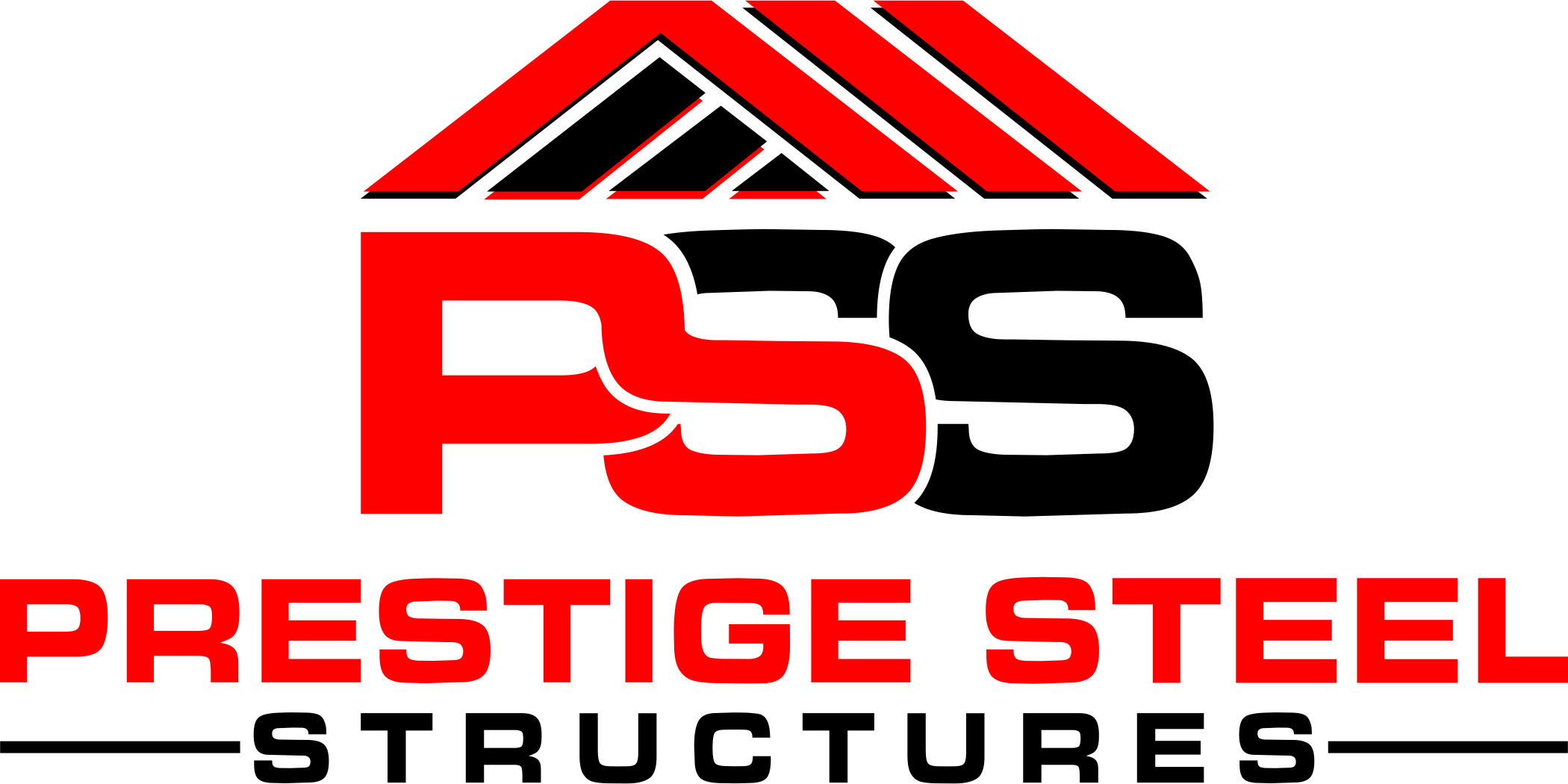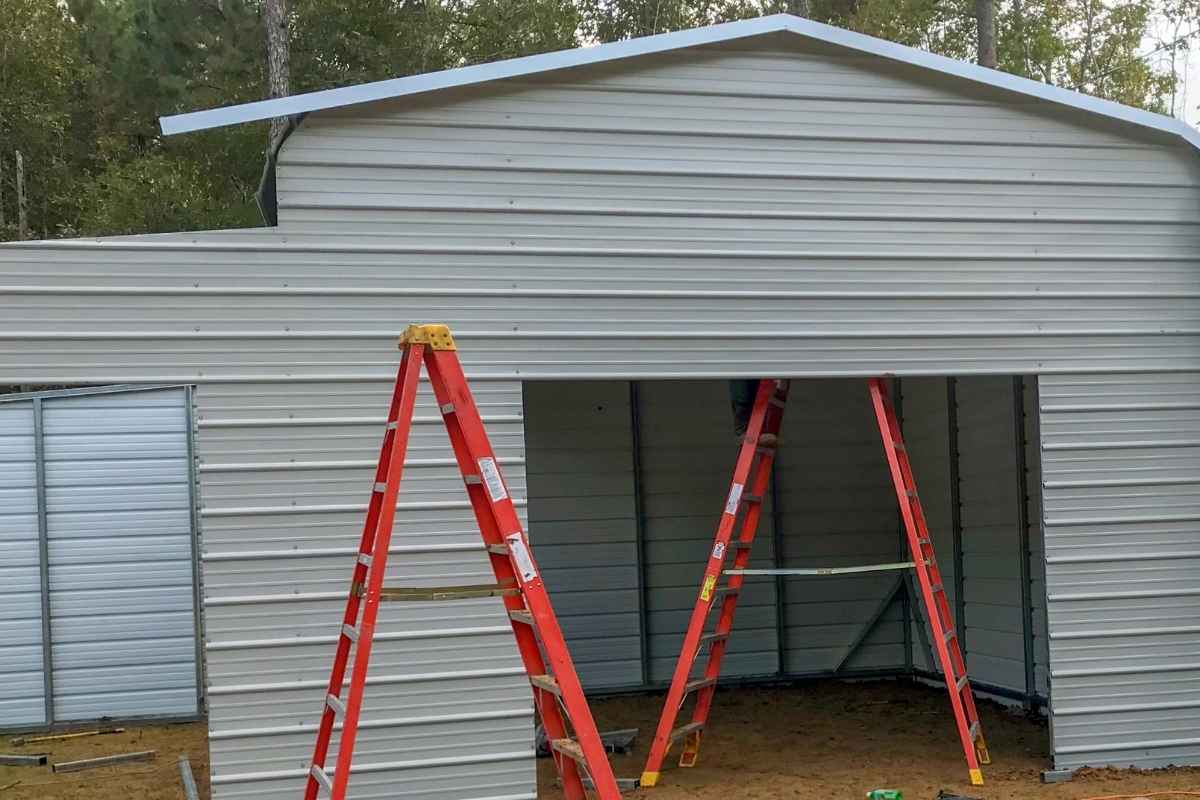When planning a metal building, the thickness of the concrete slab is a crucial factor for structural integrity and longevity. It ensures the building can support its intended load, resist cracking, and remain stable over time. The slab must be tailored to the building’s use whether for storage, workshops, or heavy equipment. Other key factors include soil conditions, reinforcement needs, and local building codes. Choosing the correct slab thickness from the start helps avoid costly repairs and ensures safety and performance.
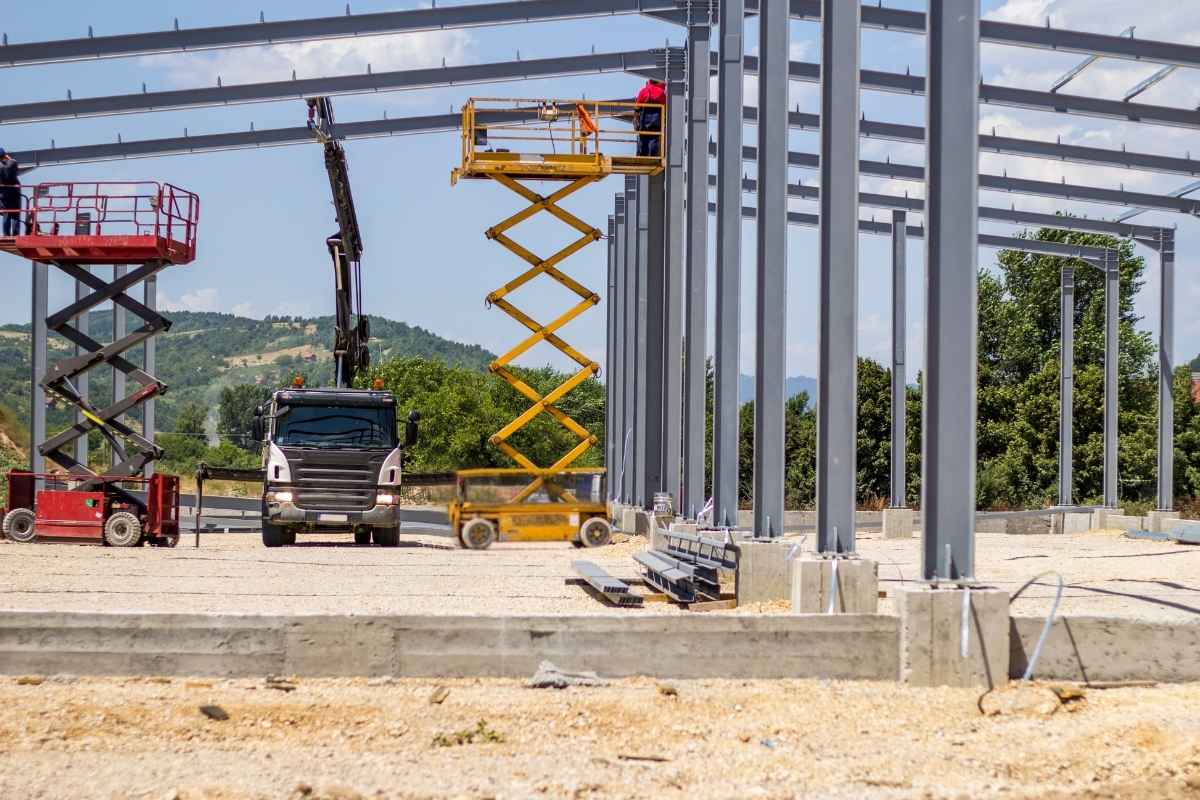
Factors That Influence Concrete Slab Thickness for Metal Buildings
(Why It’s Not One-Size-Fits-All)
When planning a metal building, the thickness of the concrete slab underneath it is one of the most important decisions you’ll make. Many people assume there’s a “standard” thickness for all slabs, but the truth is, it’s not one-size-fits-all. Several important factors determine how thick your slab should be to ensure the building stays strong and lasts a long time. Let’s break them down:
Soil Type (Clay vs. Sandy Soil)
The kind of soil under your building is critical. Different soils have different strengths.
- Clay soils tend to expand when wet and shrink when dry. This movement can cause the concrete slab to crack if it’s not thick enough.
- Sandy soils drain water quickly and stay more stable. This makes them easier to build on, and they usually require less reinforcement.
Before pouring a slab, it’s important to test the soil. If the soil is weak, you may need a thicker slab or extra support like gravel bases or soil stabilization treatments.
Action tip: Always invest in a soil test before finalizing your slab design.
Building Load (Light Use vs. Industrial/Heavy-Duty)
How you plan to use the building matters a lot.
- A light-use building, like a small workshop or storage shed, puts very little stress on the slab. A thinner slab, maybe 4 to 5 inches, might be enough.
- An industrial or heavy-duty building, such as a factory or a warehouse with forklifts and heavy machinery, demands much more. These buildings often require slabs 6 inches thick or more, sometimes reinforced with steel rebar or fiber mesh.
Action tip: Be honest about how the building will be used now—and how it might be used in the future.
Weather and Freeze/Thaw Cycles
If your area experiences freezing winters, the slab design needs extra attention.
- When water freezes in the ground under the slab, it expands, causing the slab to move, crack, or heave.
- Repeated freeze/thaw cycles can do serious damage over time if the slab isn’t properly designed.
A thicker slab, combined with good drainage systems and insulation (like rigid foam boards under the slab), can help prevent these problems.
Action tip: If you live in a cold climate, ask your builder about adding frost protection measures.
Seismic Activity Zones
If you’re building in an area prone to earthquakes, slab thickness becomes even more critical.
- Seismic forces can shift and twist a building’s foundation very suddenly.
- A thin slab might break apart, while a thicker, properly reinforced slab can better absorb and spread out the forces.
In high-risk zones, special engineering may be required, like installing seismic ties or deepened footings.
Action tip: Check if your region is in a seismic zone and follow expert engineering advice for your slab design.
Local Building Codes
No matter where you’re building, local building codes will have specific rules about minimum slab thickness.
- These codes are there for your protection, based on years of experience with the local climate, soil, and other conditions.
- Codes might also require inspections at different stages of the pour to make sure everything meets safety standards.
Ignoring building codes can lead to fines, construction delays, or even having to tear out and redo the work.
Action tip: Always check local building codes early in the planning stage—and make sure your contractor is familiar with them too.
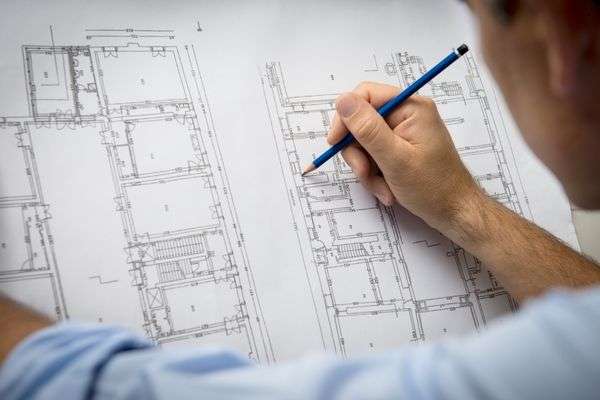
Metal Buildings and Design
Crafting the Ideal Steel Building Kit: Design with Purpose, Build with Confidence
At Prestige Steel Structures, we specialize in providing fully customized metal building solutions designed to align with your vision and functional needs. Whether you’re planning a small backyard workshop or a large-scale commercial facility, we offer a streamlined process that brings your project to life under one trusted roof. Our all-in-one building kits are engineered for convenience, offering everything you need to get started without the hassle of coordinating multiple vendors. From concept to delivery, we make it easy to move forward confidently with your next metal building project.
Every structure from Prestige Steel Structures is crafted for maximum durability, strength, and long-term performance. Our buildings are made with industry-leading steel materials and constructed with precision to stand strong against the elements. Whether you need a building for agricultural use, industrial operations, workshops, or storage, each metal structure is engineered to provide dependable protection year after year. With decades of combined experience, our team ensures that every project meets the highest standards of quality and resilience.
The success of any metal building starts with choosing the right materials and design approach. At Prestige Steel Structures, we guide you through important considerations like load requirements, site conditions, and intended usage to ensure your building is ready to perform at its best. With the right planning and expertise, your structure will stand strong through time, weather, and changing needs. Our commitment to excellence ensures your investment delivers lasting value from day one.
Steel Structures Reinvented: The Modern Answer to Traditional Construction
Prefabricated metal buildings offer a range of benefits to our clients, making them the ideal Prefabricated steel buildings have transformed the way people approach construction, offering a smarter alternative to traditional methods. These modern structures are engineered for long-term durability, weather resistance, and overall reliability. Choosing a metal building means your investment is protected against harsh conditions and unexpected maintenance costs. Clients appreciate the low upkeep and consistent performance that come with every well-built structure.
One of the standout advantages of this type of construction is its unmatched flexibility. Whether you need extra storage, a functional workshop, or a warehouse for operations, these structures adapt easily. A metal building can serve residential, commercial, and even industrial purposes with equal efficiency. Our team works with you to customize every feature so it fits your exact vision and layout. You get both form and function in one complete solution.
Customer support is at the heart of our process. From the first design meeting to the final installation, we’re with you at every stage. Our team helps you evaluate your needs, recommend options, and ensure the build meets your goals. We take pride in guiding clients through every step with clear communication and expert advice. With Prestige Steel Structures, you get more than a structure, you gain a reliable partner in your building journey.
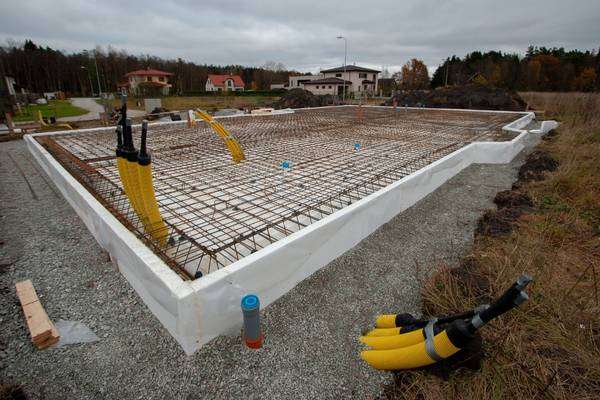
Concrete Foundations and Site Preparation
Laying the Groundwork: Concrete Foundations and Delivery Tailored to Your Project
At Prestige Steel Structures, we know that starting a construction project can feel overwhelming. That’s why we provide flexible options designed to make the process easier from day one. Whether you’re building on your own land or need assistance with installation, we’ve got you covered.
When it comes to construction projects, a durable foundation is essential for long-term stability and performance. Expert concrete work plays a critical role in preparing any structure to withstand the test of time. A well-executed concrete slab provides the strength and support necessary for a variety of building types, ensuring a solid start to any project.
Every foundation installation begins with a thorough site assessment, ground preparation, and careful planning to meet structural needs and comply with local building codes. Attention to detail at every stage — from initial evaluation to final finishing — guarantees a foundation built for lasting success.
Each project is strategically managed to align with timelines, site conditions, and overall construction goals. Skilled teams focus on efficiency, budget adherence, and maintaining the highest safety standards. A strong, properly installed foundation is more than just the first step — it’s the groundwork for a successful build. Through a proactive, hands-on approach, projects stay on schedule, on budget, and stress-free.
Why Every Steel Building Starts Strong With a Solid Concrete Slab
A solid concrete slab is the first step toward a long-lasting, dependable structure. It gives your steel building a clean, level base that supports proper assembly and structural integrity. This type of foundation helps prevent shifting, settling, and moisture-related damage over time. With a reliable slab in place, your building remains stable and secure through every season.
If you plan to use your space for a church, restaurant, retail shop, or office, a smooth and even foundation is essential. It provides the right surface for interior flooring, equipment installation, and daily use. Concrete also simplifies maintenance and improves the overall look and feel of your interior. Every commercial space benefits from starting on a properly poured slab.
What Comes First? Smart Prep Before Pouring a Concrete Base
Before construction begins, proper site preparation is essential to ensure a strong and stable foundation. The first step is clearing the area of any obstructions, such as overgrown grasses, shrubs, fallen branches, or leftover materials. Removing old sheds, fencing, or other structures is also crucial for creating a clean work zone. This preparation phase sets the stage for a successful and smooth installation process.
Once the space is cleared, the next critical step is leveling the ground. An uneven surface can lead to poor foundation performance and future structural issues. A level site allows the concrete slab to cure properly and provides a flat, even base for your future building. Whether you’re installing a garage, workshop, or metal building, getting the groundwork right ensures long-term durability.
Taking time to prepare your site correctly not only saves headaches later but also improves the efficiency of the entire build. It gives your construction team a solid, workable space and helps avoid costly delays. With smart prep, you lay the groundwork for a flawless foundation and a reliable structure.
Next-Level Building Kits with Seamless Concrete Integration for Elevated Results
Delivering strength, safety, and reliability starts with using top-quality materials and expert craftsmanship. High-performance building kits and concrete solutions are designed to withstand the test of time, offering durability and confidence in every project.
Available in a wide range of styles and sizes, these kits provide flexible options to suit a variety of spaces and functions. With easy-to-follow instructions and detailed visuals, assembly is made straightforward, allowing builders of all experience levels to achieve professional results.
Regardless of project size or complexity, the focus remains on completing each build efficiently, safely, and with expert attention to detail. Experienced teams assist in selecting the right configuration based on specific needs and property layouts, offering support throughout delivery and optional setup to ensure a smooth, hassle-free experience from start to finish.
Whether constructing a garage, storage unit, or a metal building for commercial use, every step is approached with precision and care. From foundation preparation to final placement, every detail matters. Choosing a professional-grade solution ensures that your structure not only meets but exceeds expectations—built to perform, built to last.
Steel on Solid Ground: Building with Concrete the Right Way
Every enduring structure starts with a strong, carefully prepared foundation. Before any concrete is poured, a thorough site inspection ensures the ground is properly leveled and ready for construction. This critical step helps prevent future structural issues and promotes long-term durability.
Once the surface is confirmed flat and stable, the process of building the foundation begins with precision and care. Multiple components work together to create a base designed for strength and resilience:
- Pier Pads: Distribute weight evenly and support the structure’s overall load.
- Perimeter Footer: Encircles the foundation for added reinforcement and stability.
- Compacted Base Layer: Typically four inches of gravel or sand are laid to improve drainage and reduce the risk of water-related issues.
- Reinforcement Materials: Wire mesh, rebar, plastic sheeting, and anchor bolts are integrated to enhance structural integrity and provide essential connection points.
After preparation, a concrete slab—usually four to six inches thick—is poured according to the project’s specifications. This slab becomes the secure, reliable platform that allows buildings to withstand weather, ground movement, and daily use.
Once the concrete is fully cured, construction proceeds with confidence, backed by a foundation built for lasting performance and peace of mind.
Concrete Foundation Pricing Demystified: What You Really Pay For
Pricing out a concrete foundation for your project involves more than just square footage and concrete depth. When planning a metal building, several key elements affect the total cost. The size of the slab, thickness of the concrete, and site accessibility all play major roles. Just as important is the work required to safely install the slab, each project demands a unique approach based on its location and complexity.
Mobilization fees are another critical cost factor often overlooked. These include the time, fuel, and resources required to transport both crew and equipment to and from your job site. For smaller jobs, this can feel like a larger portion of the budget. However, on larger builds, these costs are often spread out and become more manageable. Understanding these fees upfront helps you avoid surprises and plan more accurately.
Site prep adds another layer of complexity to your budget. Drainage solutions, for instance, are essential and can be costly if not handled correctly. Improper water flow can compromise the integrity of your slab and create expensive future issues. In some areas, the soil may require subgrade materials to support the slab, especially in unstable or sandy regions. These materials improve stability but add to the bottom line.
Installation challenges also affect pricing. If your site is tight or difficult to access, crews may need special equipment or alternative strategies. That could raise costs due to added time, tools, or labor. We take all of these variables into account to give you a clear and honest quote. Contact us today, and we’ll prepare a detailed estimate tailored to your specific project needs.
New Concrete and Hairline Cracks: Natural or a Red Flag?
It’s not unusual to spot small, hairline cracks on freshly poured concrete. These minor fractures, often called shrinkage cracks, occur as the concrete dries and settles. In most cases, they are purely cosmetic and don’t impact the slab’s performance. As long as your site has been properly graded and drainage is working as intended, these cracks aren’t a cause for concern.
Concrete naturally expands and contracts with temperature changes. In hot weather, it may push outward against surrounding forms or objects, creating surface-level tension. This movement is expected and doesn’t affect the overall durability of the foundation. For a metal building, these subtle shifts won’t compromise the integrity of your structure when the slab is properly installed.
Built to Last: Understanding the True Lifespan of Concrete Slabs
The lifespan of a concrete slab depends largely on the quality of its initial placement, preparation, and reinforcement. When poured correctly with attention to drainage and leveling, concrete doesn’t just maintain its strength, it improves with age. A well-prepped foundation can support heavy loads and resist cracking or settling for decades with minimal maintenance.
Adding steel reinforcement is essential for structural applications that require additional support. This reinforcement helps the slab meet design strength and enhances its ability to handle stress over time. It’s a key factor in preventing early failure, especially in builds exposed to frequent use or shifting ground conditions.
Several physical properties influence long-term durability. These include shrinkage, creep, tensile and compressive strength, and overall density. Understanding these aspects helps explain why proper preparation and material selection are critical to achieving long-term results. When everything is done right from the start, it’s not unusual for a concrete slab to last a lifetime or even longer.
The Rebar Question: When Does Your Concrete Really Need Reinforcement?
Not every concrete slab requires reinforcement, but some applications absolutely do. Whether reinforcement is needed depends on the size of the slab and the type of load it will carry. In larger projects, especially those involving structural support like walls or columns, rebar is often required by code before construction can even begin. These builds demand higher strength and long-term durability.
Lighter applications such as driveways, patios, walkways, or small garden sheds typically don’t need reinforcing steel. These structures aren’t subject to heavy loads or shifting weight, so unreinforced slabs may perform just fine. However, when in doubt, it’s best to consult with a professional to determine whether reinforcement adds value or protection for your specific project.
So, what exactly is rebar? Short for “reinforcing bar,” it’s made of mild steel and comes in various thicknesses. The most commonly used sizes are 3/8″ and 1/2″ in diameter, though larger sizes exist for heavier applications. Rebar is embedded in the concrete to increase tensile strength and reduce the risk of cracking under pressure.
Reinforcement isn’t always mandatory but when it’s needed, it plays a vital role in the slab’s long-term performance. Understanding when to use it helps ensure your foundation stays strong, stable, and ready for whatever comes next.
Rebar vs. Cracks: How Much Protection Does It Actually Provide?
Yes, reinforcement plays a critical role in managing and minimizing cracks in concrete. While minor surface cracks can naturally form due to drying or shifting, tension forces are often the real culprit behind more serious issues. That’s where rebar makes a significant difference.
Rebar adds tensile strength to the slab, allowing it to withstand stress without separating or losing structural cohesion. It doesn’t eliminate all cracking, but it does help control where cracks form and how far they spread. This containment helps maintain the integrity of the slab and prevents small cracks from turning into major concerns.
More importantly, rebar helps keep the concrete from pulling apart under pressure or movement. This is especially valuable in foundations, load-bearing pads, or high-traffic surfaces. When properly placed and spaced, rebar offers a strong internal framework that enhances both durability and reliability.
In short, rebar acts like a safety net helping your concrete perform better under stress while adding years to its useful life.
Finding the Right Depth for Concrete Under Steel
Determining the proper slab thickness is an important part of preparing your site for construction. In most cases, a minimum of 4 inches is recommended to provide a solid, stable base. This depth works well for standard usage, such as workshops, light storage, or hobby spaces.
For structures expected to support heavier loads—such as vehicles, trailers, or industrial equipment—a thicker concrete foundation is essential. In these cases, a six-inch slab is typically recommended to evenly distribute the additional weight and maintain long-term structural integrity.
This increased thickness enhances the slab’s ability to withstand pressure, reducing the risk of cracking, shifting, or other damage over time.
Before construction begins, the project team carefully evaluates the structure’s design, intended use, and load requirements to determine the ideal slab depth. Every recommendation is tailored to ensure optimal performance from the start, giving you a foundation built for strength, stability, and peace of mind.
Why Prestige Is the Clear Choice for Metal and Concrete Solutions
When it comes to metal buildings, many companies leave you responsible for major parts of the project that can be overwhelming — from coordinating foundation work to managing subcontractors. Without the right support, you’re faced with time-consuming tasks like sourcing contractors, comparing bids, and juggling unpredictable schedules — all of which can cause costly delays before construction even begins.
At Prestige Steel Structures, we take the complexity out of the metal building process. While we specialize in delivering top-quality metal structures, we also provide clear guidance on how to properly prepare your site for a seamless build. Our team works closely with you to ensure you understand the necessary steps for a solid foundation and can recommend trusted resources if additional services like concrete work are needed.
By focusing 100% on precision-engineered metal buildings, Prestige Steel Structures ensures every aspect of your structure is designed and delivered to meet exacting standards. Our streamlined process saves you time, reduces project risks, and gets your building up faster — so you can move forward with confidence.
Conclusion
Choosing the right slab thickness is more than just a technical detail — it’s the backbone of your metal building’s long-term success. From light-use workshops to heavy-duty industrial spaces, a solid foundation ensures the safety, strength, and durability of your investment.
At Prestige Steel Structures, we focus on delivering premium metal buildings engineered for maximum performance. While we don’t handle concrete installation directly, we work closely with our customers to ensure they’re fully prepared for a smooth, stable build. Our expertise removes the guesswork, giving you the confidence that every aspect of your metal structure — from design to completion — is executed with precision.
Don’t leave your foundation to chance; partner with a team that understands the full scope of structural integrity. Whether you’re building for business, storage, or recreation, success starts with smart planning and a structure built to stand the test of time.
Let Prestige Steel Structures help you build smarter, stronger, and with peace of mind from the ground up.
FAQs
Can I pour a concrete slab myself for a metal building?
Yes, but it’s risky without experience. Poor drainage or uneven surfaces can cause costly structural problems later.
How long should I wait before building on a new slab?
Wait at least 7 days for curing; 28 days is ideal for full strength before heavy loads or construction.
What’s the difference between fiber mesh and rebar in concrete slabs?
Fiber mesh controls surface cracks; rebar strengthens against tension and structural stress in load-bearing applications.
Does slab thickness affect building permits or inspections?
Yes, local codes often specify minimum slab thickness and reinforcement—always check with your building authority first.
Can radiant heating be installed in a metal building slab?
Absolutely. Radiant tubing can be embedded in the concrete for efficient, even heating in garages or workshops.

